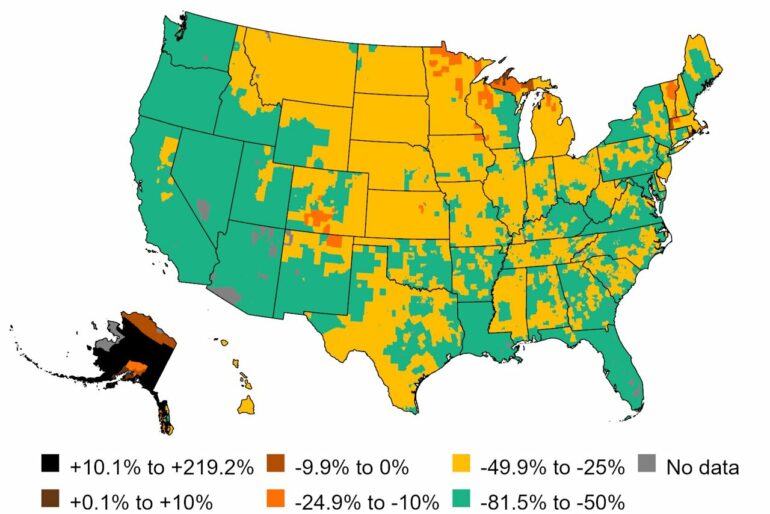More than 90% of vehicle-owning households in the United States would see a reduction in the percentage of income spent on transportation energy—the gasoline or electricity that powers their cars, SUVs and pickups—if they switched to electric vehicles.
And more than 90% of households that replace gas-powered vehicles with EVs would also reduce the amount of climate-warming greenhouse gases they generate, according to a new University of Michigan study.
However, more than half of the lowest-income U.S. households (an estimated 8.3 million households) would continue to experience high transportation energy burdens, defined in this study as spending more than 4% of household income on filling the tank or charging up.
“Our results confirm the potential for widespread benefits from EV adoption,” said study corresponding author Joshua Newell, an urban geographer at the U-M Center for Sustainable Systems, part of the School for Environment and Sustainability.
“However, EV ownership in the U.S. has thus far been dominated by households with higher incomes and education levels, leaving the most vulnerable populations behind. Policy interventions are needed to increase EV accessibility so that all Americans can benefit from the EV transition.”
The new study is scheduled for publication Jan. 11 in Environmental Research Letters. It is the first study to consider the spatial variation of both EV energy costs and greenhouse gas emissions across the country.
It’s also the first study to examine EV energy costs through the lens of distributive justice by calculating the EV energy burden (percentage of income spent on EV charging) for the entire United States. Distributive justice concerns the fair distribution of benefits and burdens.
EVs currently account for about 1% of the cars, SUVs and pickups on American roads. If all those vehicles were replaced with new EVs, the transportation energy burdens and associated greenhouse gas emissions would vary widely from place to place, according to the new study.
Reductions in both transportation energy burden and GHG emissions would be especially pronounced on the West Coast and in parts of the Northeast, due largely to cleaner energy grids and lower electricity prices.
Households in some locations could reduce their annual transportation-energy costs by $600 or more, and cut their annual carbon footprint by more than 4.1 metric tons of carbon dioxide equivalents, by buying a new EV.
But lower-income households in other parts of the country wouldn’t fare as well, Newell said.
Very high EV transportation energy burdens, ranging from 10% to 64%, would persist for the lowest-income households and would be concentrated in the Midwest and in the two states with the highest electricity prices: Hawaii and Alaska.
Eight percent of U.S. households (an estimated 9.6 million households) would see low savings in both transportation energy burden and greenhouse gas emissions by choosing an EV. “Both low” households are scattered across the country, with about half of them in Midwest states, including Michigan.
Factors that contribute to those low EV savings include cold winter temperatures that impact battery performance, electrical grids that rely largely on fossil fuels, or electricity prices that are higher relative to gasoline prices.
According to the study, the lowest-income households would continue to experience the highest transportation energy burdens. Essentially all households with incomes of less than 30% of the local median would experience moderate or high EV energy burdens.
“We identified disparities that will require targeted policies to promote energy justice in lower-income communities—including the subsidizing of charging infrastructure—as well as strategies to reduce electricity costs and increase the availability of low-carbon transportation modes such as public transit, bicycling and car sharing,” said study lead author Jesse Vega-Perkins, who did the work for a master’s thesis at the U-M School for Environment and Sustainability.
“Our analysis indicates that future grid decarbonization, current and future fuel prices, and charging accessibility will impact the extent to which EV benefits will be realized, including lowering transportation energy burdens for low-income households,” said study senior author Greg Keoleian, director of U-M’s Center for Sustainable Systems.
The study used a geospatial model to evaluate three factors associated with the EV transition: transportation energy burden, fuel costs (meaning the cost of gasoline or the electricity needed to charge an EV) and greenhouse gas emissions.
The analysis does not include vehicle purchase cost. Total cost of ownership of EVs is the focus of a current study by the Center for Sustainable Systems.
The researchers calculated transportation energy burdens and lifetime greenhouse gas emissions of new battery-electric and internal-combustion vehicles at the census tract level. Then they compared the energy burdens of the new vehicles to the energy burdens of the current on-road vehicle stock. Finally, they compared the spatial variation and extent of energy burdens and greenhouse gas emissions for EVs and internal-combustion vehicles across the U.S.
Transportation accounts for the largest portion of the greenhouse gases emitted in the United States, with direct emissions from passenger vehicles and light-duty trucks comprising roughly 16% of U.S. emissions. Electrification is seen as the primary pathway to reducing those emissions.
More information:
Jesse Vega-Perkins et al, Mapping electric vehicle impacts: greenhouse gas emissions, fuel costs, and energy justice in the United States, Environmental Research Letters (2023). DOI: 10.1088/1748-9326/aca4e6
Provided by
University of Michigan
Citation:
EV transition will benefit most US vehicle owners, but lowest-income Americans could get left behind (2023, January 11)



